Interconnection between the Southern South China Sea and the Java Sea through the Karimata Strait
Abstract
:1. Introduction
2. Data and Methods
2.1. Model Description and Configuration
2.2. Analytical Techniques
2.2.1. Model Validation
2.2.2. Wind Stress and Wind Stress Curl
2.2.3. Water Transports
3. Results and Discussion
3.1. Wind Stress and Wind Stress Curl
3.2. Meal Sea Levels
3.3. Surface Current
3.4. Sea Surface Temperature and Salinity
3.5. Water Advection
3.6. Seasonal Cycles
3.7. Volume, Freshwater, Heat, and Salt Transports
3.7.1. Annual Water Transports
3.7.2. Seasonal Water Transports
4. Summary and Conclusions
Supplementary Materials
Author Contributions
Funding
Institutional Review Board Statement
Informed Consent Statement
Data Availability Statement
Acknowledgments
Conflicts of Interest
References
- Fang, G.; Chen, H.; Wei, Z.; Wang, Y.; Wang, X.; Li, C. Trends and interannual variability of the South China Sea surface winds, surface height, and surface temperature in the recent decade. J. Geophys. Res. Space Phys. 2006, 111, 1–16. [Google Scholar] [CrossRef] [Green Version]
- Wyrtki, K. Physical Oceanography of the Southeast Asian Waters. In NAGA Report; University of California: La Jolla, LA, USA, 1961; Volume 2, p. 195. [Google Scholar]
- Taira, K.; Saadon, M.N.B.; Kitagawa, S.; Yanagi, T. Observation of temperature and velocity in the coastal water off Kuala Terengganu, Malaysia. J. Oceanogr. 1996, 52, 251–257. [Google Scholar] [CrossRef]
- Morgan, J.R.; Valencia, M.J. The Natural Environmental Setting. In Atlas for Marine Policy in Southeast Asian Seas; Morgan, J.R., Valencia, M.J., Eds.; University of California: La Jolla, LA, USA, 1983; pp. 4–17. [Google Scholar]
- Sadhomoto, B. Review of environmental features of the Java Sea. Indones. Fish Res. J. 2006, 12, 129–157. [Google Scholar] [CrossRef] [Green Version]
- Hendiarti, N.; Siegel, H.; Ohde, T. Investigation of different coastal processes in Indonesian waters using SeaWiFS data. Deep. Sea Res. Part II Top. Stud. Oceanogr. 2004, 51, 85–97. [Google Scholar] [CrossRef]
- Dale, W.L. Winds and drift currents in the South China Sea. Malays. J. Trop Geogr. 1956, 8, 1–31. [Google Scholar]
- Liu, Q.; Feng, M.; Wang, D. ENSO-induced interannual variability in the southeastern South China Sea. J. Oceanogr. 2011, 67, 127–133. [Google Scholar] [CrossRef]
- Akhir, M.F.M. Surface circulation and temperature distribution of southern South China Sea from Global Ocean Model (OCCAM). Sains Malays. 2012, 41, 701–714. [Google Scholar]
- Tangang, F.; Xia, C.; Qiao, F.; Juneng, L.; Shan, F. Seasonal circulations in the Malay Peninsula Eastern continental shelf from a wave-tide-circulation coupled model. Ocean Dyn. 2011, 61, 1317–1328. [Google Scholar] [CrossRef]
- Fang, G.; Fang, W.; Fang, Y.; Wang, K. A survey of studies on the South China sea upper ocean circulation. Acta Oceanogr. Taiwanica. 1998, 37, 1–16. [Google Scholar]
- Daryabor, F.; Samah, A.A.; Ooi, S.H.; Chenoli, S.N. An estimate of the Sunda Shelf and the Strait of Malacca transports: A nu-merical study. Ocean Sci. Discuss. 2015, 12, 275–313. [Google Scholar] [CrossRef]
- Daryabor, F.; Ooi, S.H.; Abu Samah, A.; Akbari, A. Dynamics of the Water Circulations in the Southern South China Sea and Its Seasonal Transports. PLoS ONE 2016, 11, e0158415. [Google Scholar] [CrossRef] [Green Version]
- Atmadipoera, A.S.; Kusmanto, E.; Purwandana, A.; Nurjaya, I.W. Observation of coastal front and circulation in the north-eastern Java Sea, Indonesia. J. Ilmu. dan Teknol. Kelaut. Trop. 2015, 7, 91–108. [Google Scholar]
- Qu, T. Role of ocean dynamics in determining the mean seasonal cycle of the South China Sea surface temperature. J. Geophys. Res. Space Phys. 2001, 106, 6943–6955. [Google Scholar] [CrossRef]
- Durand, J.R.; Petit, D. The Java Sea Environment. In Biology, Dynamics, Exploitation of the Small Pelagic Fishes in the Java Sea; Potier, M., Nurhakim, S., Eds.; Agency for Agricultural Research and Development: Jakarta, Indonesia, 1995; pp. 15–38. [Google Scholar]
- Qu, T.; Du, Y.; Sasaki, H. South China Sea throughflow: A heat and freshwater conveyor. Geophys. Res. Lett. 2006, 33, 1–4. [Google Scholar] [CrossRef]
- Gordon, A. Oceanography of the Indonesian Seas and Their Throughflow. Oceanography 2005, 18, 14–27. [Google Scholar] [CrossRef]
- Sofian, I. Simulation of the Java Sea using an oceanic general circulation model. J. Ilmu. Geomatika. 2007, 13, 1–14. [Google Scholar]
- Gordon, A.L.; Susanto, R.D.; Vranes, K. Cool Indonesian throughflow as a consequence of restricted surface layer flow. Nature 2003, 425, 824–828. [Google Scholar] [CrossRef] [PubMed]
- Fang, G.; Susanto, R.D.; Wirasantosa, S.; Qiao, F.; Supangat, A.; Fan, B.; Wei, Z.; Sulistiyo, B.; Li, S. Volume, heat, and freshwater transports from the South China Sea to Indonesian seas in the boreal winter of 2007–2008. J. Geophys. Res. Space Phys. 2010, 115. [Google Scholar] [CrossRef] [Green Version]
- Susanto, R.D.; Wei, Z.; Adi, R.T.; Fan, B.; Li, S.; Fang, G. Observations of the Karimata Strait througflow from December 2007 to November 2008. Acta Oceanol. Sin. 2013, 32, 1–6. [Google Scholar] [CrossRef]
- He, Z.; Feng, M.; Wang, D.; Slawinski, D. Contribution of the Karimata Strait transport to the Indonesian Throughflow as seen from a data assimilation model. Cont. Shelf Res. 2015, 92, 16–22. [Google Scholar] [CrossRef]
- Cai, S.; Liu, H.; Long, X. Application of LICOM to the numerical study of water exchange between the South China Sea and its adjacent oceans. Acta Oceanol. Sin. 2005, 24, 10–19. [Google Scholar]
- Fang, G.; Wei, Z.; Choi, B.-H.; Wang, K.; Fang, Y.; Li, W. Interbasin freshwater, heat and salt transport through the boundaries of the East and South China Sea from a variable-grid ocean circulation model. Sci. China (Ser. D) 2003, 46, 149–161. [Google Scholar] [CrossRef]
- Fang, G.; Wang, Y.; Wei, Z.; Fang, Y.; Qiao, F.; Hu, X. Interocean circulation and heat and freshwater budgets of the South China Sea based on a numerical model. Dyn. Atmos. Oceans 2009, 47, 55–72. [Google Scholar] [CrossRef]
- Guohong, F.; Susanto, D.; Soesilo, I.; Zheng, Q.; Fangli, Q.; Zexun, W. A note on the South China Sea shallow interocean circulation. Adv. Atmos. Sci. 2005, 22, 946–954. [Google Scholar] [CrossRef]
- Shchepetkin, A.F.; McWilliams, J.C. The regional oceanic modeling system (ROMS): A split-explicit, free-surface, topography-following-coordinate oceanic model. Ocean Model. 2005, 9, 347–404. [Google Scholar] [CrossRef]
- Haidvogel, D.B.; Arango, H.; Budgell, W.P.; Cornuelle, B.D.; Curchitser, E.; Di Lorenzo, E.; Fennel, K.; Geyer, W.R.; Hermann, A.J.; Lanerolle, L.; et al. Ocean forecasting in terrain-following coordinates: Formulation and skill assessment of the Regional Ocean Modeling System. J. Comput. Phys. 2008, 227, 3595–3624. [Google Scholar] [CrossRef]
- GEBCO Bathymetric Compilation Group. The GEBCO_2019 Grid—A Continuous Terrain Model of the Global Oceans and Land; British Oceanographic Data Centre, National Oceanography Centre: Southampton, UK, 2019. [Google Scholar]
- Sikirić, M.D.; Janeković, I.; Kuzmić, M. A new approach to bathymetry smoothing in sigma-coordinate ocean models. Ocean Model. 2009, 29, 128–136. [Google Scholar] [CrossRef]
- Copernicus Climate Change Service (C3S). Fifth Generation of ECMWF Atmospheric Reanalyses of the Global Climate. In ERA5 Fifth Gener ECMWF Atmos Reanalyses Glob Clim; Copernicus Climate Change Service (C3S): Reading, UK, 2017. [Google Scholar]
- Cummings, J.A. Operational multivariate ocean data assimilation. Q. J. R. Meteorol. Soc. 2005, 131, 3583–3604. [Google Scholar] [CrossRef] [Green Version]
- Cummings, J.A.; Smedstad, O.M. Variational Data Assimilation for the Global Ocean; Springer: Berlin/Heidelberg, Germany, 2013; pp. 303–343. [Google Scholar] [CrossRef]
- Fox, D.N.; Teague, W.J.; Barron, C.N.; Carnes, M.R.; Lee, C.M. The Modular Ocean Data Assimilation System (MODAS). J. Atmos. Ocean Technol. 2002, 19, 240–252. [Google Scholar] [CrossRef]
- Wijeratne, S.; Pattiaratchi, C.; Proctor, R. Estimates of Surface and Subsurface Boundary Current Transport Around Australia. J. Geophys. Res. Oceans 2018, 123, 3444–3466. [Google Scholar] [CrossRef]
- Marchesiello, P.; McWilliams, J.C.; Shchepetkin, A.F. Open boundary conditions for long-term integration of regional oceanic models. Ocean Model. 2001, 3, 1–20. [Google Scholar] [CrossRef]
- Egbert, G.D.; Erofeeva, S.Y. Efficient inverse modeling of barotropic ocean tides. J. Atmos. Ocean Technol. 2002, 19, 183–204. [Google Scholar] [CrossRef] [Green Version]
- Flather, R.A. A tidal model of the north-west European continental shelf. Mem. Soc. R. Sci. Liege. 1976, 6, 141–164. [Google Scholar]
- Chapman, D.C. Numerical Treatment of Cross-Shelf Open Boundaries in a Barotropic Coastal Ocean Model. J. Phys. Oceanogr. 1985, 15, 1060–1075. [Google Scholar] [CrossRef] [Green Version]
- Barnier, B.; Siefridt, L.; Marchesiello, P. Thermal forcing for a global ocean circulation model using a three-year climatology of ECMWF analyses. J. Mar. Syst. 1995, 6, 363–380. [Google Scholar] [CrossRef]
- Maltrud, M.E.; Smith, R.D.; Semtner, A.J.; Malone, R.C. Global eddy-resolving ocean simulations driven by 1985–1995 atmospheric winds. J. Geophys. Res. Ocean 1998, 103, 30825–30853. [Google Scholar] [CrossRef]
- Barth, A.; Alvera-Azcárate, A.; Beckers, J.-M.; Rixen, M. Coupling a two-way nested primitive equation model and a statistical SST predictor of the Ligurian Sea via data assimilation. Ocean Model. 2006, 13, 255–270. [Google Scholar] [CrossRef]
- Gordon, A.L.; Huber, B.A.; Metzger, E.J.; Susanto, R.D.; Hurlburt, H.E.; Adi, T.R. South China Sea throughflow impact on the Indonesian throughflow. Geophys. Res. Lett. 2012, 39, 1–7. [Google Scholar] [CrossRef] [Green Version]
- Seo, H.; Xie, S.-P.; Murtugudde, R.; Jochum, M.; Miller, A.J. Seasonal Effects of Indian Ocean Freshwater Forcing in a Regional Coupled Model. J. Clim. 2009, 22, 6577–6596. [Google Scholar] [CrossRef]
- Guilyardi, E.; Swingedouw, D.; Mignot, J.; Labetoulle, S.; Servonnat, J.; Séférian, R. Reconstructing the subsurface ocean decadal variability using surface nudging in a perfect model framework. Clim. Dynam. 2015, 44, 315–338. [Google Scholar] [CrossRef]
- Holgate, S.J.; Matthews, A.; Philip, L.; Woodworth, L.J.R.; Tamisiea, M.E.; Bradshaw, E.; Foden, P.R.; Gordon, K.M.; Jevrejeva, S.; Pugh, J. New data systems and products at the Permanent Service for Mean Sea Level. J. Coast Res. 2013, 29, 493–504. [Google Scholar] [CrossRef]
- Fernandez, E.; Lellouche, J.M. Product User Manual for the Global Ocean Physical Reanalysis Product GLOBAL_REANALYSIS_PHY_001_030; Corpernicus Marine Service: Toulouse, France, 2021; Volume 2.1, 21p. [Google Scholar]
- Drévillon, M.; Lellouche, J.-M.; Régnier, C.; Garric, G.; Bricaud, C.; Hernandez, O.; Bourdallé-Badie, R. Quality Information Document for GLOBAL_REANALYSIS_PHY_001_030; Corpernicus Marine Service: Toulouse, France, 2021; Volume 1.4, 52p. [Google Scholar]
- Lorente, P.; García-Sotillo, M.; Amo-Baladrón, A.; Aznar, R.; Levier, B.; Sánchez-Garrido, J.C.; Sammartino, S.; De Pascual, A.; Reffray, G.; Toledano, C.; et al. Skill assessment of global, regional, and coastal circulation forecast models: Evaluating the benefits of dynamical downscaling in IBI (Iberia–Biscay–Ireland) surface waters. Ocean Sci. 2019, 15, 967–996. [Google Scholar] [CrossRef] [Green Version]
- Feldman, G.C.; McClian, C.R. Terra & Aqua—MODIS Reprocessing; Kuring, N., Bailey, S.W., Eds.; Ocean Color Web: Greenbelt, ML, USA, 2014. [Google Scholar]
- Boyer, T.P.; Garcia, H.E.; Locarnini, R.A.; Zweng, M.M.; Mishonov, A.V.; Reagan, J.R.; Weathers, K.A.; Baranova, O.K.; Paver, C.R.; Seidov, D.; et al. World Ocean Atlas. 2018 [Internet]. NOAA National Centers for Environmental Information. 2018. Available online: https://accession.nodc.noaa.gov/NCEI-WOA18 (accessed on 18 August 2021).
- Levitus, S.; Boyer, T. World Ocean Atlas; National Oceanic and Atmospheric Administration: Washington, DC, USA, 1994; 117p. [Google Scholar]
- Ffield, A.; Gordon, A.L.; Susanto, R.D.; Garzoli, S.L.; Vranes, K. Temperature variability within Makassar Strait. Geophys. Res. Lett. 2000, 27, 237–240. [Google Scholar] [CrossRef]
- Schiller, A.; Godfrey, J.S.; McIntosh, P.C.; Meyers, G.; Wijffels, S. Seasonal Near-Surface Dynamics and Thermodynamics of the Indian Ocean and Indonesian Throughflow in a Global Ocean General Circulation Model. J. Phys. Oceanogr. 1998, 28, 2288–2312. [Google Scholar] [CrossRef]
- Kok, P.H.; Akhir, M.F.; Tangang, F. Thermal frontal zone along the east coast of Peninsular Malaysia. Cont. Shelf Res. 2015, 110, 1–15. [Google Scholar] [CrossRef]
- Kok, P.H.; Akhir, M.F.M.; Tangang, F.; Husain, M.L. Spatiotemporal trends in the southwest monsoon wind-driven upwelling in the southwestern part of the South China Sea. PLoS ONE 2017, 12, e0171979. [Google Scholar] [CrossRef]
- Daryabor, F.; Tangang, F.; Juneng, L. Simulation of southwest monsoon current circulation and temperature in the east coast of peninsular Malaysia. Sains Malays. 2014, 43, 389–398. [Google Scholar]
- Akhir, M.F.; Daryabor, F.; Husain, M.L.; Tangang, F.; Qiao, F. Evidence of upwelling along Peninsular Malaysia during south-west monsoon. Open J. Mar. Sci. 2015, 5, 273–279. [Google Scholar] [CrossRef] [Green Version]
- Kok, P.H.; Akhir, M.F.; Qiao, F. Distinctive characteristics of upwelling along the Peninsular Malaysia’s east coast during 2009/10 and 2015/16 El Niños. Cont. Shelf Res. 2019, 184, 10–20. [Google Scholar] [CrossRef]
- Pickett, M.H.; Paduan, J.D. Ekman transport and pumping in the California Current based on the U.S. Navy’s high-resolution atmospheric model (COAMPS). J. Geophys. Res. 2003, 108, 1–10. [Google Scholar] [CrossRef]
- Castelao, R.M.; Barth, J.A. Upwelling around Cabo Frio, Brazil: The importance of wind stress curl. Geophys. Res. Lett. 2006, 33, 1–4. [Google Scholar] [CrossRef]
- Pérez-Santos, I.; Schneider, W.; Sobarzo, M.; Montoya-Sánchez, R.; Valle-Levinson, A.; Garcés-Vargas, J. Surface wind variability and its implications for the Yucatan basin–Caribbean Sea dynamics. J. Geophys. Res. Space Phys. 2010, 115, 1–15. [Google Scholar] [CrossRef] [Green Version]
- Tkalich, P.; Vethamony, P.; Babu, M.T.; Malanotte-Rizzoli, P. Storm surges in the Singapore Strait due to winds in the South China Sea. Nat. Hazards 2012, 66, 1345–1362. [Google Scholar] [CrossRef] [Green Version]
- Minola, L.; Zhang, F.; Azorin-Molina, C.; Pirooz, A.A.S.; Flay, R.G.J.; Hersbach, H.; Chen, D. Near-surface mean and gust wind speeds in ERA5 across Sweden: Towards an improved gust parametrization. Clim. Dyn. 2020, 55, 887–907. [Google Scholar] [CrossRef]
- Jiang, Y.; Han, S.; Shi, C.; Gao, T.; Zhen, H.; Liu, X. Evaluation of HRCLDAS and ERA5 Datasets for Near-Surface Wind over Hainan Island and South China Sea. Atmosphere 2021, 12, 766. [Google Scholar] [CrossRef]
- Liu, Y.; Lin, M.; Jiang, X.; Sun, X.; Song, X. A comparison of multiplatform wind products in the South China Sea during summer and autumn in 2019. J. Oceanol. Limnol. 2021, 1–14. [Google Scholar] [CrossRef]
- Wyrtki, K. Die Zirkulation an der Oberfläche der südostasiatischen Gewässer. Dtsch. Hydrogr. Z. 1957, 10, 1–13. [Google Scholar] [CrossRef]
- Mayer, B.; Damm, P.E. The Makassar Strait throughflow and its jet. J. Geophys. Res. Space Phys. 2012, 117, 1–14. [Google Scholar] [CrossRef]
- Tozuka, T.; Qu, T.; Yamagata, T. Dramatic impact of the South China Sea on the Indonesian Throughflow. Geophys. Res. Lett. 2007, 34, 1–5. [Google Scholar] [CrossRef]
- Du, Y.; Qu, T. Three inflow pathways of the Indonesian throughflow as seen from the simple ocean data assimilation. Dyn. Atmos. Oceans 2010, 50, 233–256. [Google Scholar] [CrossRef]
- Chu, P.; Edmons, N.L.; Fan, C. Dynamical Mechanisms for the South China Sea Seasonal Circulation and Thermohaline Variabilities. J. Phys. Oceanogr. 1999, 29, 2971–2989. [Google Scholar] [CrossRef]
- Daryabor, F.; Abu Samah, A.; Ooi, S.H. Dynamical structure of the sea off the east coast of Peninsular Malaysia. Ocean Dyn. 2014, 65, 93–106. [Google Scholar] [CrossRef]
- Susanto, R.D.; Fang, G.; Soesilo, I.; Zheng, Q.; Qiao, F.; Wei, Z.; Sulistyo, B. New Surveys of a Branch of the Indonesian Throughflow. Eos 2010, 91, 261–263. [Google Scholar] [CrossRef]
- Sprintall, J.; Wijffels, S.; Gordon, A.L.; Ffield, A.; Molcard, R.; Susanto, R.D.; Soesilo, I.; Sopaheluwakan, J.; Surachman, Y.; Van Aken, H.M. Instant: A new international array to measure the Indonesian Throughflow. Eos 2004, 85, 369–376. [Google Scholar] [CrossRef]
- Rhines, P.B.; Eddies, M. Encyclopedia of Ocean Sciences; Steele, J.H., Ed.; Elsevier: Cambridge, UK, 2001; pp. 1717–1730. [Google Scholar]
- Chelton, D.B.; Schlax, M.G.; Samelson, R.M. Global observations of nonlinear mesoscale eddies. Prog. Oceanogr. 2011, 91, 167–216. [Google Scholar] [CrossRef]
- McGillicuddy, D.J.; Robinson, A.R.; Siegel, D.A.; Jannasch, H.W.; Johnson, R.; Dickey, T.D.; McNeil, J.; Michaels, A.F.; Knap, A.H. Influence of mesoscale eddies on new production in the Sargasso Sea. Nature 1998, 394, 263–266. [Google Scholar] [CrossRef]
- Garçon, V.C.; Oschlies, A.; Doney, S.; McGillicuddy, D.; Waniek, J. The role of mesoscale variability on plankton dynamics in the North Atlantic. Deep. Sea Res. Part II Top. Stud. Oceanogr. 2001, 48, 2199–2226. [Google Scholar] [CrossRef]
- Robinson, A.R.; Leslie, W.G.; Theocharis, A.; Lascaratos, A. Mediterranean Sea Circulation. In Encyclopedia of Ocean Sciences; Steele, J.H., Ed.; Academic Press: Cambridge, UK, 2001; pp. 1689–1705. [Google Scholar]
- Lonin, S.A.; Hernández, J.L.; Palacios, D.M. Atmospheric events disrupting coastal upwelling in the southwestern Caribbean. J. Geophys. Res. Space Phys. 2010, 115, 1–4. [Google Scholar] [CrossRef]
- Chu, P.C.; Wang, G. Seasonal variability of thermohaline front in the central South China Sea. J. Oceanogr. 2003, 59, 65–78. [Google Scholar] [CrossRef]
- Liu, Q.; Jiang, X.; Liu, W.T. A gap in the Indo-Pacific warm pool over the South China Sea in boreal winter: Seasonal development and interannual variability. J. Geophys. Res. 2004, 109, 1–10. [Google Scholar] [CrossRef] [Green Version]
- Utama, F.G.; Atmadipoera, A.; Purba, M.; Sudjono, E.H.; Zuraida, R. Analysis of upwelling event in Southern Makassar Strait. IOP Conf. Ser. Earth Environ. Sci. 2017, 54, 12085. [Google Scholar] [CrossRef] [Green Version]
- Ffield, A.; Gordon, A.L. Vertical Mixing in the Indonesian Thermocline. J. Phys. Oceanogr. 1992, 22, 184–195. [Google Scholar] [CrossRef] [Green Version]
- Nababan, B.; Rosyadi, N.; Manurung, D.; Natih, N.M.; Hakim, R. The Seasonal Variability of Sea Surface Temperature and Chlorophyll-a Concentration in the South of Makassar Strait. Procedia Environ. Sci. 2016, 33, 583–599. [Google Scholar] [CrossRef] [Green Version]
- Susanto, R.D.; Moore, T.; Marra, J. Ocean color variability in the Indonesian Seas during the SeaWiFS era. Geochem. Geophys. Geosyst. 2006, 7, 1–16. [Google Scholar] [CrossRef]
- Cai, S.; Su, J.; Long, X.; Wang, S.; Huang, Q. Numerical study on the summer circulation of the upper South China Sea and its establishment. Acta Oceanol. Sin. 2005, 1, 31–38. [Google Scholar]
- Yanagi, T.; Sachoemar, S.I.; Takao, T.; Fujiwara, S. Seasonal Variation of Stratification in the Gulf of Thailand. J. Oceanogr. 2001, 57, 461–470. [Google Scholar] [CrossRef]
- Qiao, F.; Yang, Y.; Lü, X.; Xia, C.; Chen, X.; Wang, B.; Yuan, Y. Coastal upwelling in the East China Sea in winter. J. Geophys. Res. Space Phys. 2006, 111, 1–11. [Google Scholar] [CrossRef] [Green Version]
- Zweng, M.; Reagan, J.R.; Seidov, D.; Boyer, T.P.; Locarnini, R.A.; Garcia, H.E.; Mishonov, A.V.; Baranova, O.K.; Weathers, K.W.; Paver, C.R.; et al. World Ocean Atlas 2018 Salinity; Mishonov, A., Ed.; NOAA Atlas NESDIS 82; National Centers for Environmental Information: Silver Sprin, MA, USA, 2019; Volume 2, 50p. [Google Scholar]
- Boyer, T.; Levitus, S.; Garcia, H.; Locarnini, R.A.; Stephens, C.; Antonov, J. Objective analyses of annual, seasonal, and monthly temperature and salinity for the World Ocean on a 0.25° grid. Int. J. Clim. 2005, 25, 931–945. [Google Scholar] [CrossRef]
- JPL. JPL CAP SMAP Sea Surface Salinity Products. Ver. 5.0. [Internet]. PO.DAAC. 2020. Available online: https://podaac.jpl.nasa.gov/announcements/2020-12-11-JPL-SMAP-SSS-CAP-V5.0-Dataset-Release (accessed on 20 August 2021).
- Fore, A.G.; Yueh, S.H.; Tang, W.; Stiles, B.W.; Hayashi, A.K. Combined Active/Passive Retrievals of Ocean Vector Wind and Sea Surface Salinity With SMAP. IEEE Trans. Geosci. Remote Sens. 2016, 54, 7396–7404. [Google Scholar] [CrossRef]
- Chen, X.; Liu, Z.; Wang, H.; Xu, D.; Wang, L. Significant salinity increase in subsurface waters of the South China Sea during 2016–2017. Acta Oceanol. Sin. 2019, 38, 51–61. [Google Scholar] [CrossRef]
- Wyrtki, K. Scientific Results of Marine Investigations of the South China Sea and the Gulf of Thailand 1959–1961. In Naga Report; Scripps Institute of Oceanography: La Jolla, CA, USA, 1961; Volume 2, p. 195. [Google Scholar]
- Zhang, X.; Sun, C.; Liu, C.; Zhang, L.; Shao, C.; Zhang, X.; Zhao, Y. Evaluation of the Impact of Argo Data on Ocean Reanalysis in the Pacific Region. Adv. Meteorol. 2017, 2017, 1–12. [Google Scholar] [CrossRef] [Green Version]
- Martin, M.; Balmaseda, M.; Bertino, L.; Brasseur, P.; Brassington, G.; Cummings, J.; Fujii, Y.; Lea, D.; Lellouche, J.-M.; Mogensen, K.; et al. Status and future of data assimilation in operational oceanography. J. Oper. Oceanogr. 2015, 8, s28–s48. [Google Scholar] [CrossRef]
- Edwards, C.A.; Moore, A.M.; Hoteit, I.; Cornuelle, B.D. Regional Ocean Data Assimilation. Annu. Rev. Mar. Sci. 2015, 7, 21–42. [Google Scholar] [CrossRef] [PubMed] [Green Version]
- Giddings, S.N.; Fong, D.A.; Monismith, S.G.; Chickadel, C.C.; Edwards, K.A.; Plant, W.J.; Wang, B.; Fringer, O.; Horner-Devine, A.R.; Jessup, A.T. Frontogenesis and Frontal Progression of a Trapping-Generated Estuarine Convergence Front and Its Influence on Mixing and Stratification. Chesap. Sci. 2011, 35, 665–681. [Google Scholar] [CrossRef]
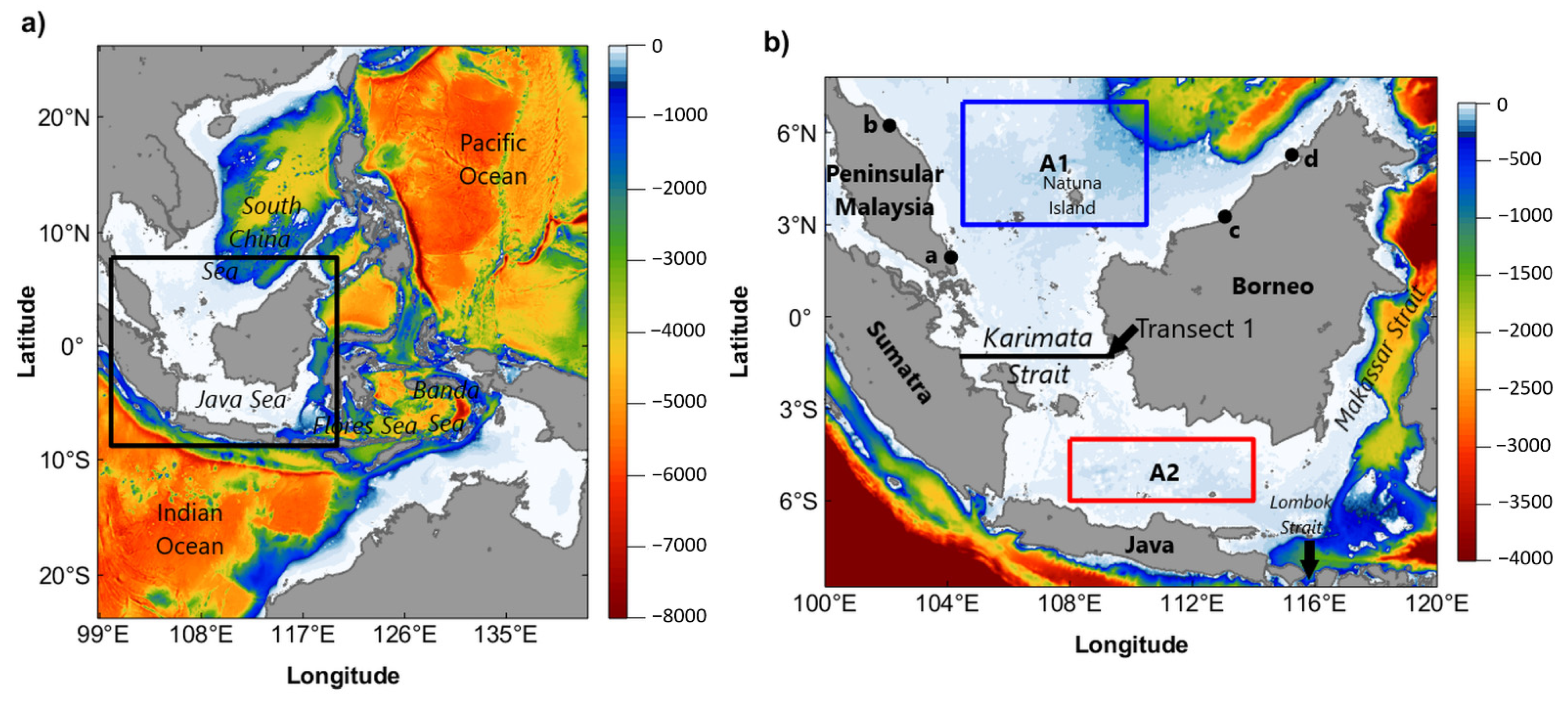
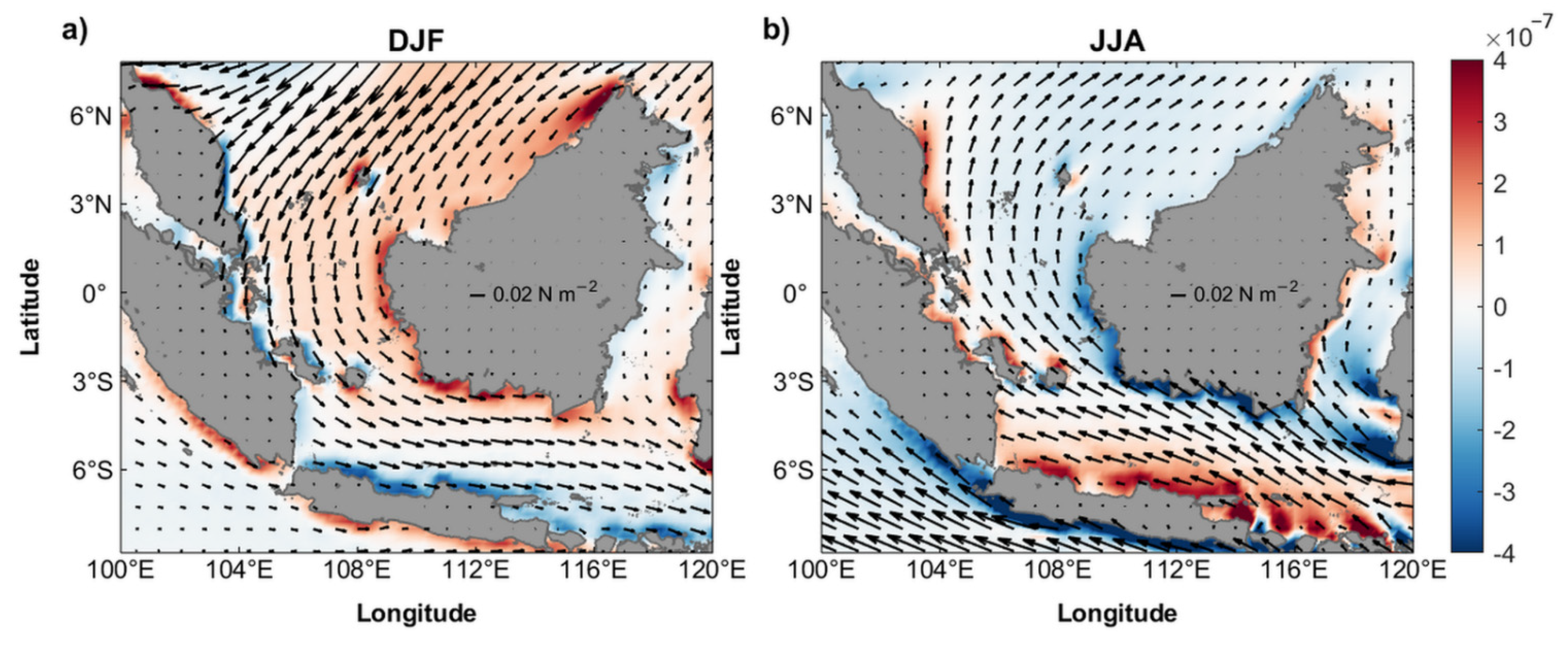
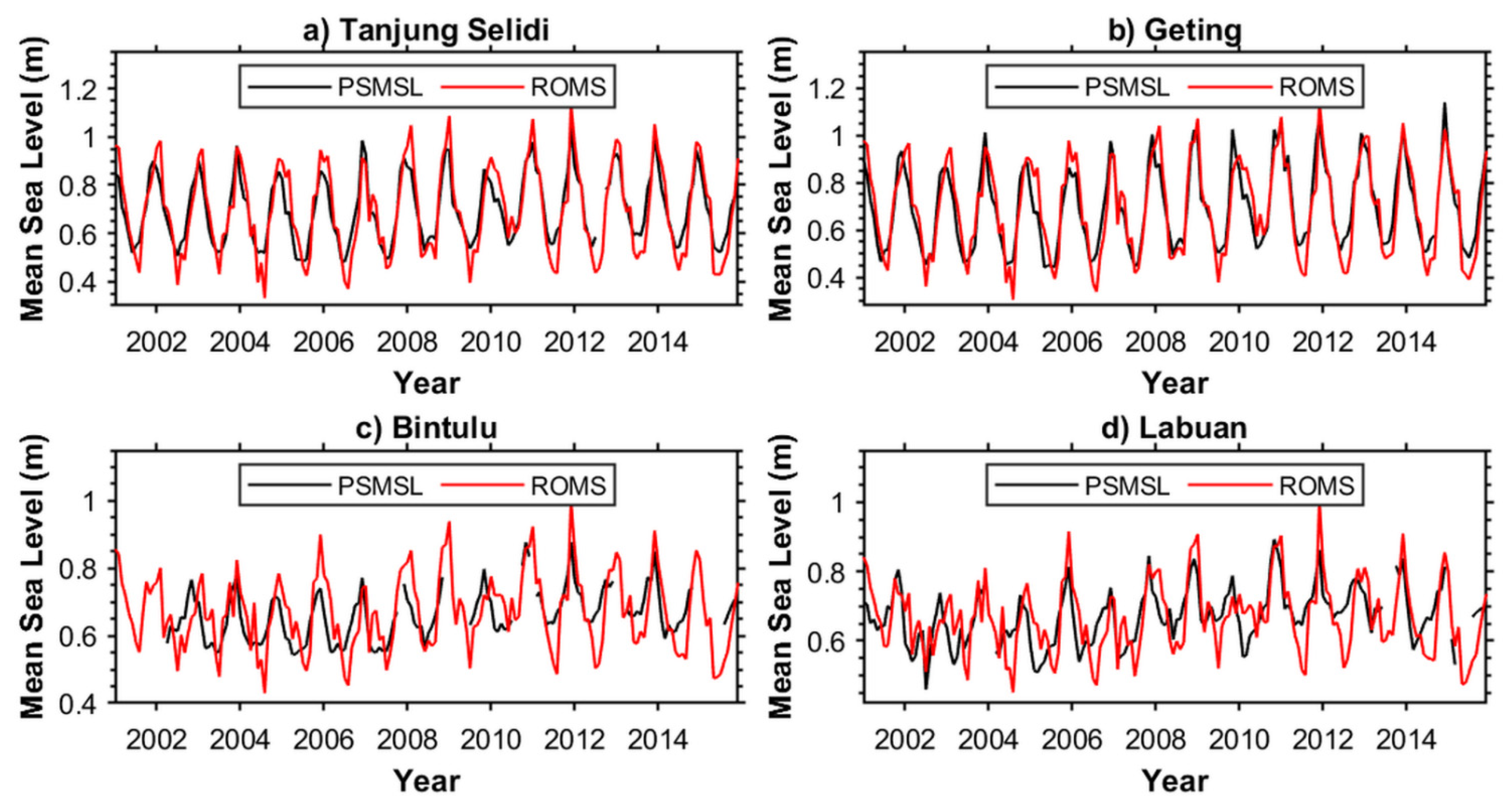
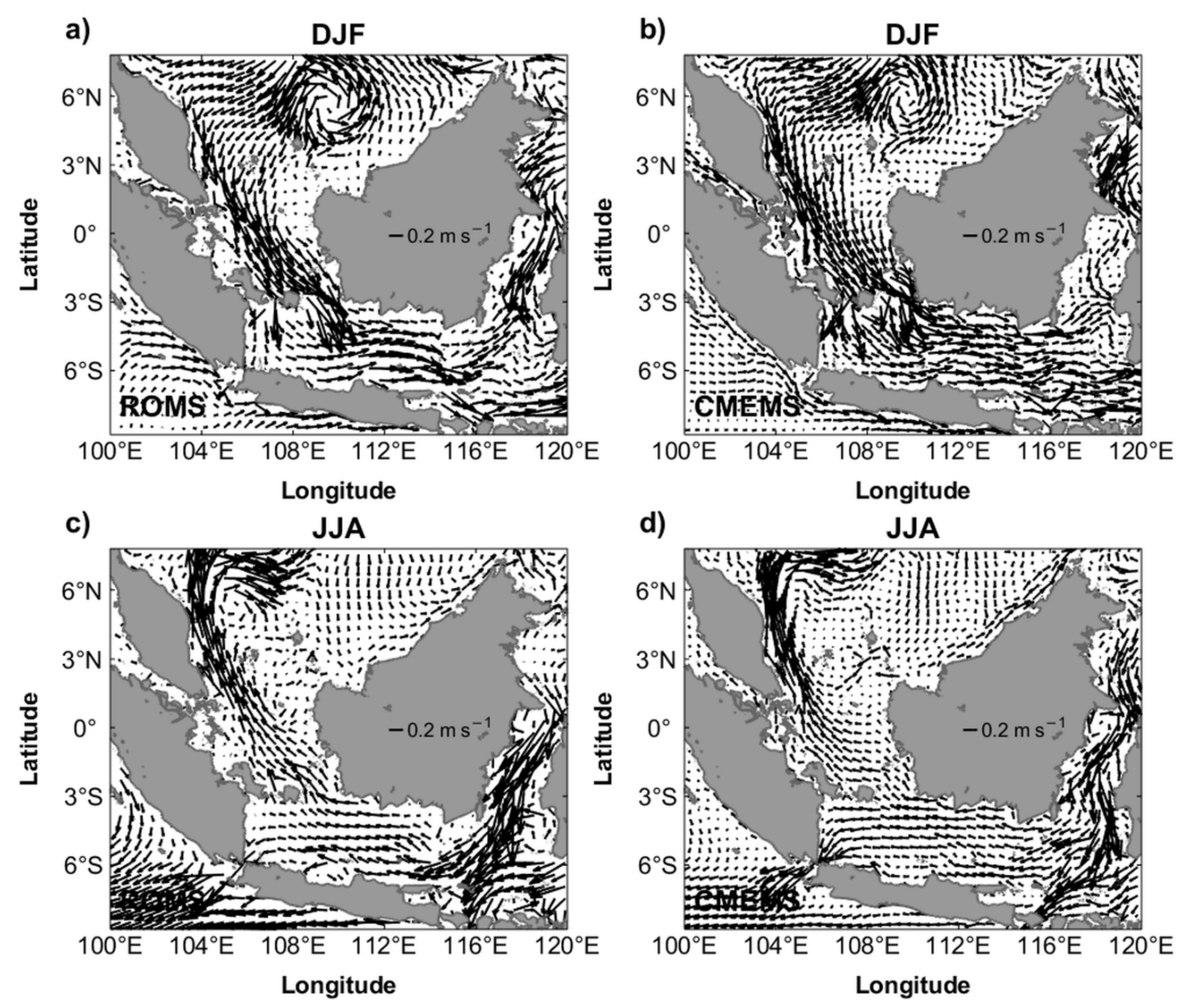
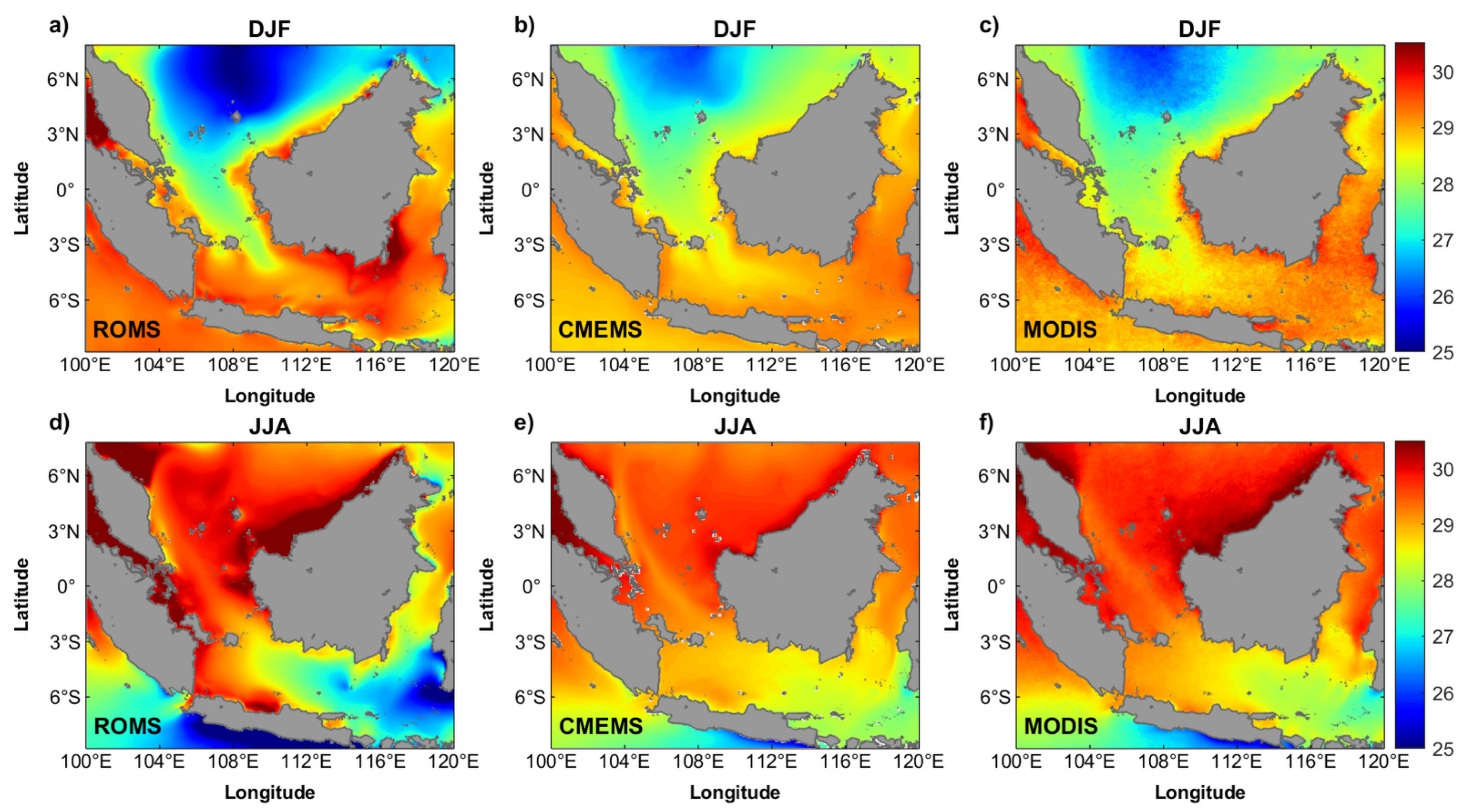
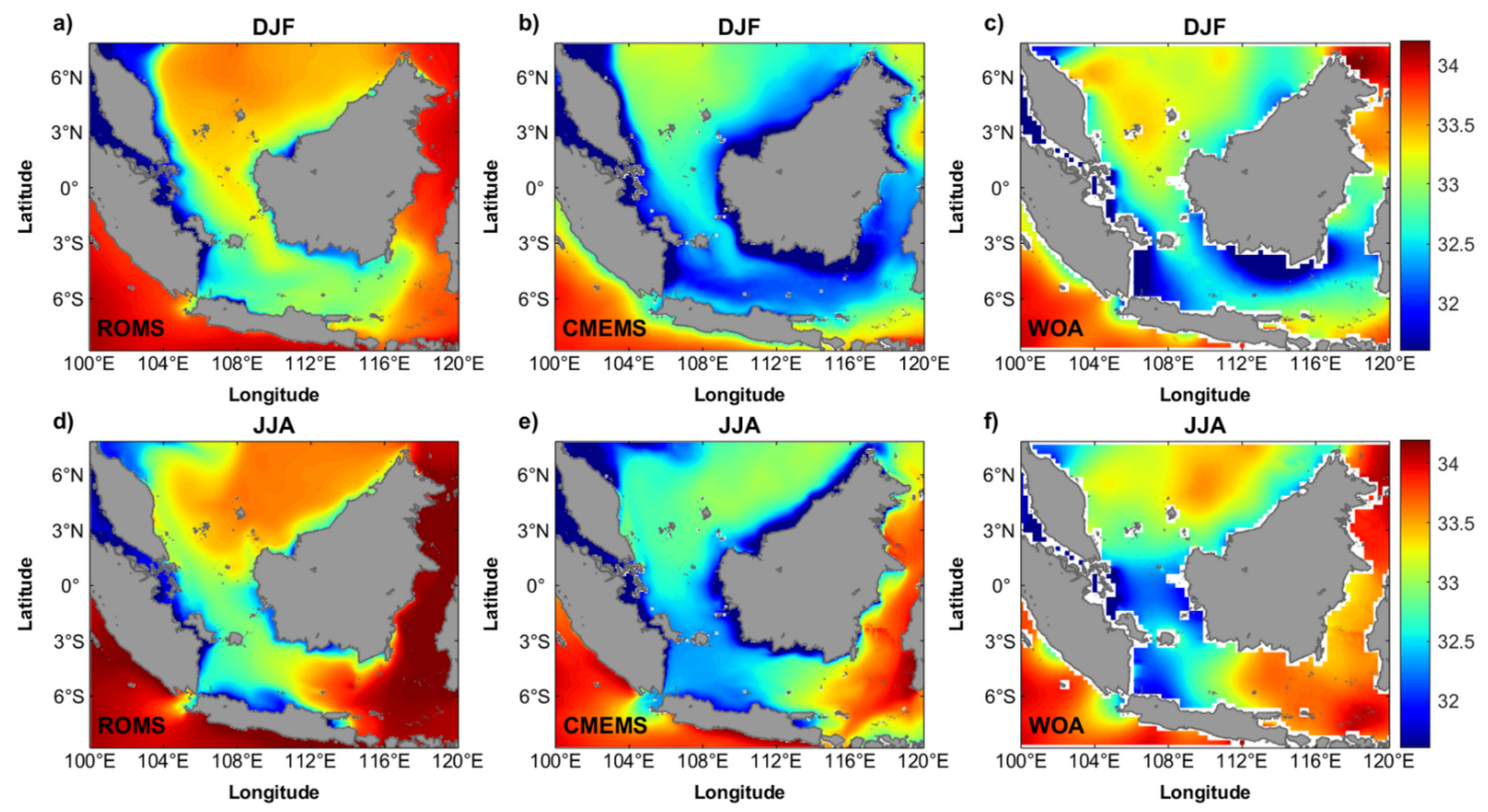

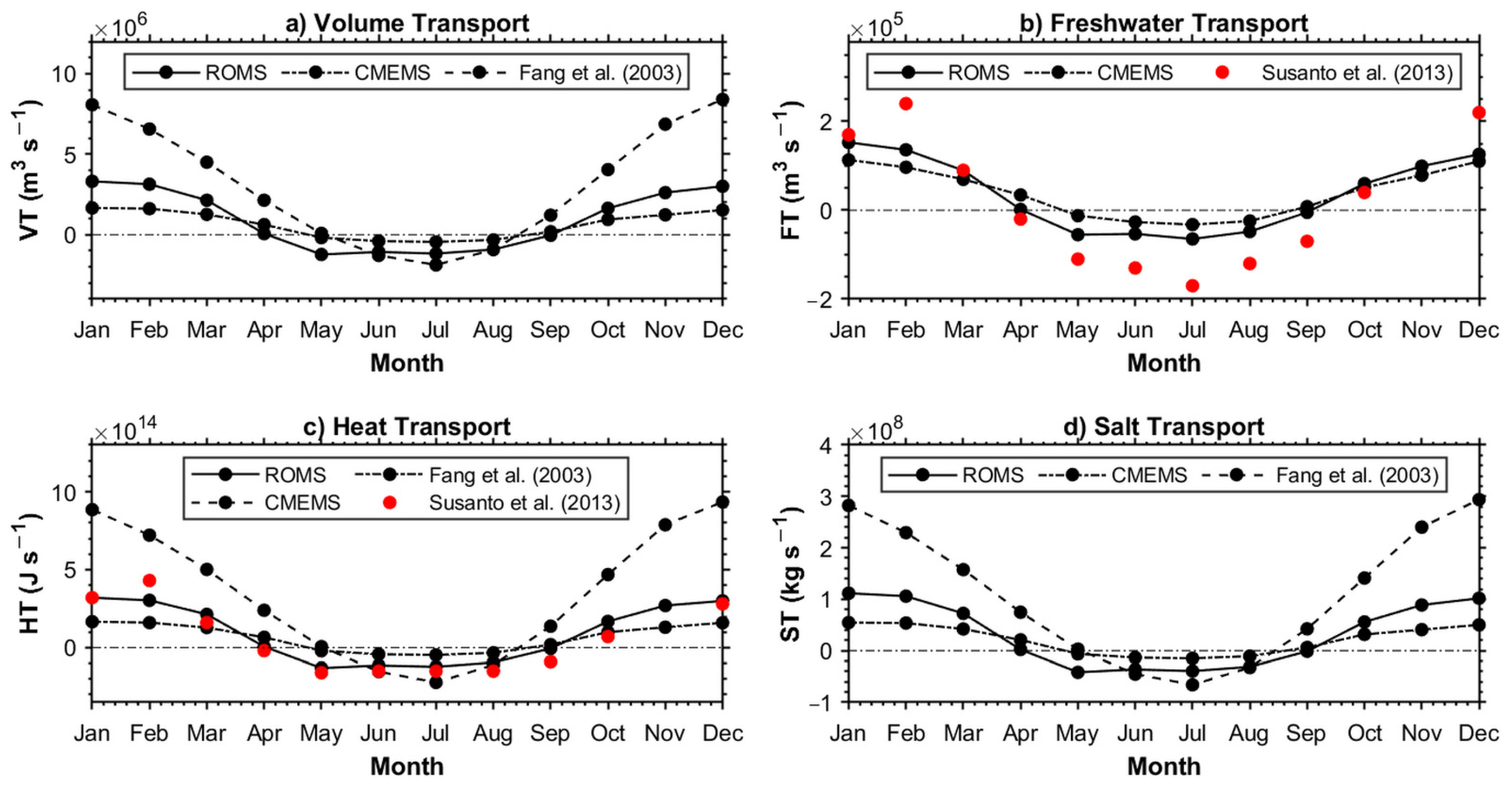
| Author | Model | Domain | Horizontal Resolution (°) | Vertical Resolution | Annual Transport | |||
|---|---|---|---|---|---|---|---|---|
| FV | FW | FH | FS | |||||
| Fang et al. [25] | MOM Version 2 | Outer: Global Ocean Inner: SCS, East China Sea, Japan/East Sea | Outer: 3 Inner: 1/6 | 15 levels | 3.15 | - | 0.35 | 0.11 |
| Cai et al. [24] | LICOM | 75° S–65° N | 1/2 | 12 levels | 1.86 | - | 0.17 | 0.07 |
| Fang et al. [26] | MOM Version 2 | Outer: 87° N–Southern Antarctic Coast Inner: 20° S–60° N, 98–156° E | Outer: ±2 Inner: 1/6 | 18 levels | 1.16 | 0.05 | 0.11 | 0.04 |
| - | CMEMS | Global Ocean | 1/12 | 50 z-levels | 0.64 | 0.04 | 0.07 | 0.02 |
| Present Study | ROMS | 23.65° S–25.97° N, 98.82–142.22° E | 1/20 × 1/25 | 30 levels | 0.96 | 0.04 | 0.10 | 0.03 |
Publisher’s Note: MDPI stays neutral with regard to jurisdictional claims in published maps and institutional affiliations. |
© 2021 by the authors. Licensee MDPI, Basel, Switzerland. This article is an open access article distributed under the terms and conditions of the Creative Commons Attribution (CC BY) license (https://creativecommons.org/licenses/by/4.0/).
Share and Cite
Kok, P.H.; Wijeratne, S.; Akhir, M.F.; Pattiaratchi, C.; Roseli, N.H.; Mohamad Ali, F.S. Interconnection between the Southern South China Sea and the Java Sea through the Karimata Strait. J. Mar. Sci. Eng. 2021, 9, 1040. https://doi.org/10.3390/jmse9101040
Kok PH, Wijeratne S, Akhir MF, Pattiaratchi C, Roseli NH, Mohamad Ali FS. Interconnection between the Southern South China Sea and the Java Sea through the Karimata Strait. Journal of Marine Science and Engineering. 2021; 9(10):1040. https://doi.org/10.3390/jmse9101040
Chicago/Turabian StyleKok, Poh Heng, Sarath Wijeratne, Mohd Fadzil Akhir, Charitha Pattiaratchi, Nur Hidayah Roseli, and Fariz Syafiq Mohamad Ali. 2021. "Interconnection between the Southern South China Sea and the Java Sea through the Karimata Strait" Journal of Marine Science and Engineering 9, no. 10: 1040. https://doi.org/10.3390/jmse9101040









